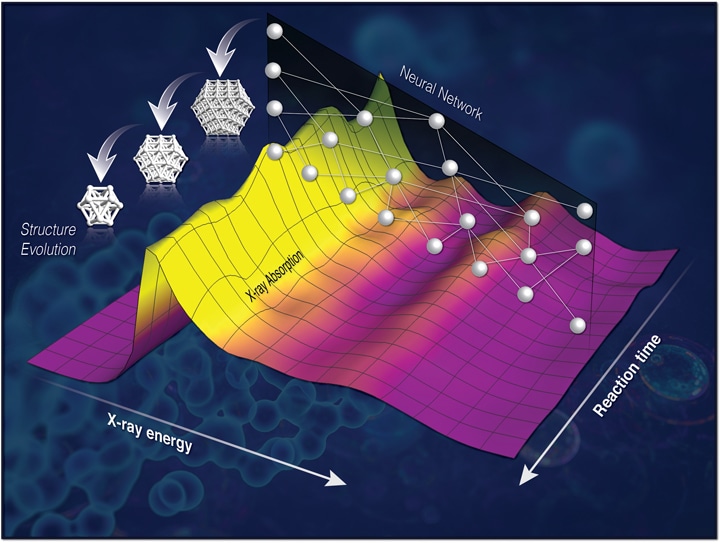Oct 11 2017
Chemistry is an intricate web of atoms. Minor shifts in position and shuffles of electrons break and re-form chemical bonds as participants change partners. Catalysts are like molecular intermediaries that make it easier for sometimes-unwilling partners to interact.
 A sketch of the new method that enables fast, "on-the-fly" determination of three-dimensional structure of nanocatalysts. The neural network converts the x-ray absorption spectra into geometric information (such as nanoparticle sizes and shapes) and the structural models are obtained for each spectrum. Credit: Brookhaven National Laboratory
A sketch of the new method that enables fast, "on-the-fly" determination of three-dimensional structure of nanocatalysts. The neural network converts the x-ray absorption spectra into geometric information (such as nanoparticle sizes and shapes) and the structural models are obtained for each spectrum. Credit: Brookhaven National Laboratory
Currently Scientists have a way to record the details of chemistry choreography as it occurs. The technique—which depends upon computers that have learned to identify hidden signs of the steps—should help them enhance the performance of catalysts to drive reactions toward preferred products sooner.
The technique—developed by an interdisciplinary team of Chemists, Physicists and Computational Scientists at the U.S. Department of Energy’s Brookhaven National Laboratory and Stony Brook University — is illustrated in a new paper published in the Journal of Physical Chemistry Letters. The paper reveals how the team used neural networks and machine learning to teach computers to decode previously isolated information from X-ray data, and then applied that data to decipher 3D nanoscale structures.
Decoding nanoscale structures
The main challenge in developing catalysts is knowing how they work—so we can design better ones rationally, not by trial-and-error. The explanation for how catalysts work is at the level of atoms and very precise measurements of distances between them, which can change as they react. Therefore it is not so important to know the catalysts’ architecture when they are made but more important to follow that as they react.
Anatoly Frenkel, Leader of the Research Team who has a joint appointment with Brookhaven Lab’s Chemistry Division and The Materials Science Department, Stony Brook University
Problem is, crucial reactions — those that produce important industrial chemicals such as fertilizers — frequently occur at high temperatures and under pressure, which complicates measurement methods. For instance, X-rays can reveal certain atomic-level structures by causing atoms that absorb their energy to release electronic waves. As those waves interact with adjacent atoms, they reveal their positions in a way that is similar to how distortions in ripples on the surface of a pond can divulge the presence of rocks. But the ripple pattern gets more complex and smeared when high pressure and heat add disorder into the structure, thereby obscuring the information the waves can reveal.
So rather than depending on the “ripple pattern” of the X-ray absorption spectrum, Frenkel’s group discovered a way to look into a different part of the spectrum related with low-energy waves that are less impacted by heat and disorder.
We realized that this part of the X-ray absorption signal contains all the needed information about the environment around the absorbing atoms. But this information is hidden ‘below the surface’ in the sense that we don’t have an equation to describe it, so it is much harder to interpret. We needed to decode that spectrum but we didn’t have a key.
Janis Timoshenko, Postdoctoral Fellow working with Frenkel at Stony Brook and Lead Author of the paper
Luckily Yuewei Lin and Shinjae Yoo of Brookhaven’s Computational Science Initiative and Deyu Lu of the Center for Functional Nanomaterials (CFN) had substantial experience with so-called machine learning approaches. They helped the team prepare a key by programming computers to locate the connections between hidden features of the absorption spectrum and structural details of the catalysts.
“Janis took these ideas and really ran with them,” Frenkel said.
The team used theoretical modeling to create simulated spectra of several hundred thousand model structures, and used those to program the computer to recognize the features of the spectrum and how they connected with the structure.
“Then we built a neural network that was able to convert the spectrum into structures,” Frenkel said.
When they tested to check if the technique would work to decipher the sizes and shapes of well-defined platinum nanoparticles (using X-ray absorption spectra published earlier by Frenkel and his partners), it did.
This method can now be used on the fly. Once the network is constructed it takes almost no time for the structure to be obtained in any real experiment.
Anatoly Frenkel, Leader of the Research Team who has a joint appointment with Brookhaven Lab’s Chemistry Division and The Materials Science Department, Stony Brook University
That means Researchers examining catalysts at Brookhaven’s National Synchrotron Light Source II (NSLS-II), for instance, could acquire real-time structural information to decipher why a specific reaction decelerates, or starts generating an undesirable product—and then modify the reaction conditions or catalyst chemistry to attain desired results. This would be a huge improvement over waiting to examine results after finishing the experiments and then guessing what went wrong.
Furthermore, this method can process and test spectral signals from very low-concentration samples, and will be mainly useful at new high flux and high-energy-resolution beamlines integrating special optics and high-throughput analysis methods at NSLS-II.
“This will offer completely new methods of using synchrotrons for operando research,” Frenkel said.
This study was funded by the DOE Office of Science (BES) and by Brookhaven’s Laboratory Directed Research and Development program. Formerly published spectra for the model nanoparticles used to authenticate the neural network were collected at the Advanced Photon Source (APS) at DOE’s Argonne National Laboratory and the original National Synchrotron Light Source (NSLS) at Brookhaven Lab, now replaced by NSLS-II. CFN, NSLS-II, and APS are DOE Office of Science User Facilities. Besides Frenkel and Timoshenko, Lu and Lin are co-authors on the paper.